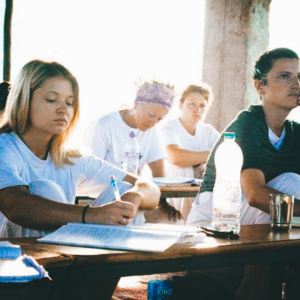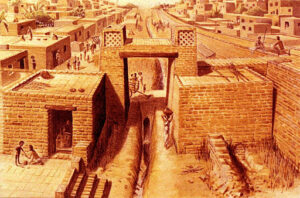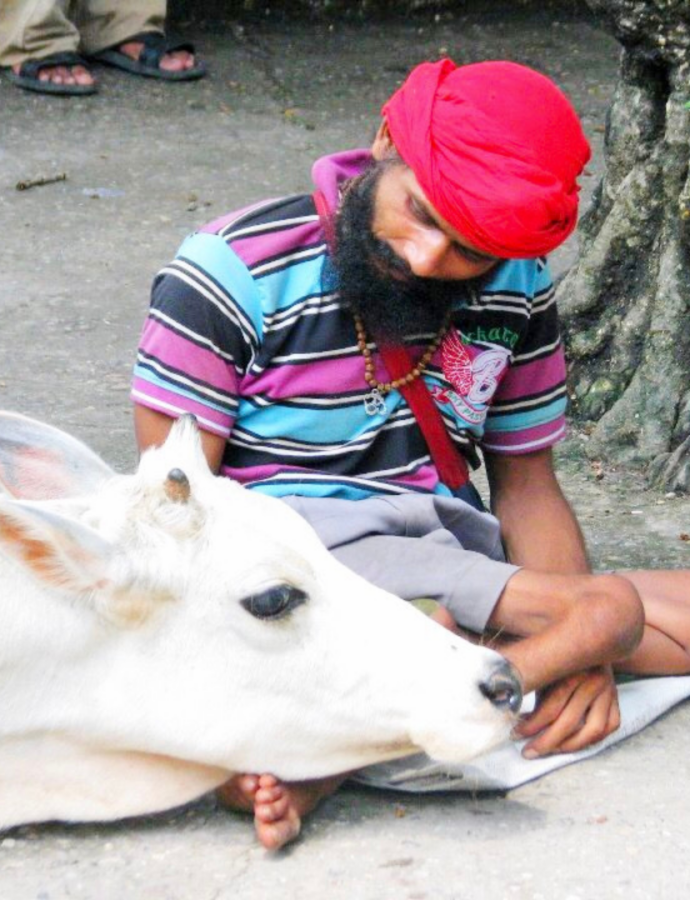
In this post, I will do my best to explain Yoga’s history according to my interpretation. The information I present has been passed on to me by some of my teachers. I have also gained insight into Yoga’s past from years of questioning and searching for answers to parts of the puzzle I felt were missing. I challenge you to do the same. I will do this in a 2-part series because summing up 5,000 years of past events in one blog post just seems silly. I hope you are as excited as I am to further understand the vastness of Yoga by learning about its boundless history.
But First, A Little Self History
I grew up in a small town in Nevada called Dayton. It had one stoplight, a few gas stations, a “take and bake pizza” place, and a whole lot of sagebrush. Dayton claims to be Nevada’s first settlement. The only problem with this declaration is a town called Genoa, located just 25 miles away, also makes this claim. Both Genoa and Dayton continue to this day to defend their title of Nevada’s birthplace.


The point of mentioning all of this is that Dayton WAS the first settlement in Nevada. But also, sometimes we cannot determine how events from the past played out because we weren’t there. Instead, we have to draw our conclusions from others’ interpretations. We can also gather evidence from written records, textual information, or recovered artifacts. This information helps explain history; however, no one can say with 100% certainty how events unfolded because it is impossible to recreate the past.
Tracing back all the events of Yoga’s past is a massive undertaking compared to the Dayton/Genoa debate. The birthplace of Nevada’s first settlement was some 170 years ago. Now, the birthplace of the Yoga tradition was said to have emerged some 5,000 years ago. Due to the complexity of all that is involved in tracing back the roots of Yoga, you can be sure to encounter conflicting opinions of how this ancient practice came to be. Please keep an open mind and feel free to explore what does not make sense to you. And now, let us begin…
Yoga Is A 5,000-Year-Old Tradition… Or Is It?
The Bronze Age

One often hears that Yoga is a 5,000 years tradition. This number comes from an ancient artifact discovered in the Indus Valley in the 1920s. The region of the Indus Valley outlines the area of what is now modern Pakistan and Northwest India. The Indus Valley civilization was one of the earliest civilizations in history. It existed during a period known as the Bronze Age. Grid-like city layouts, highly advanced cities and architecture, and advanced sewage systems were unique characteristics of this civilization. The populated city also provided a landscape for the progress of art and culture.

Much of our evidence of the Indus Valley comes from materials such as sculptures and clap pots. Many of these artifacts contain paintings of humans and animals. Clay seals have also been discovered, which may have served as a currency system. Some of the seals have symbols that have yet to be decoded.
Fun fact: Two guys from Harvard have a $10,000 reward out for anyone who can crack the Indus code if you are interested?
Mohenjo-daro was one recovered ancient city in the Indus Valley. During an archaeological dig, a significant clay seal surfaced here. The Mohenjo-daro clay seal depicts a central figure with a prominent nose, closed mouth, and intensely set eyes. The figure is possibly tricephalic (having three heads), and various animals surround him or her. The legs are elongated and occupy the length of the seat. Sir John Marshall was a key figure in these early digs of ruins. Marshall wrote up a report in 1931 and interpreted the image on the seal as a figure seated in a yogic or meditative posture. Some claim that this meditative yogi was Shiva, who is one of the principal gods in Hinduism.

Marshall’s interpretation had a profound effect on scholars and future generations; however, we cannot say with certainty that the Mohenjo-jaro seal depicted yogic or meditative postures. We also do not know if this was Shiva- the god associated with creation. The claim that Yogic practices were around during this time remains inconclusive due to the lack of decipherable texts or other discovered evidence to support these practices’ existence.
Some may say Yoga is a pure, timeless, unchanging tradition that has been around for 5,000 years and was revealed by Vedic sages. Others may claim that Yoga is continually changing and innovating. This group may believe that Yoga, mainly postural Yoga, was invented during the Colonial Period and then made its way to the West via transnationalism. Neither of these positions holds against historical evidence in its entirety. The truth of Yoga’s origin likely falls somewhere in between both views.
The Vedas
The Vedic Period

On the first day of my Yoga Philosophy class during my 500-hour teacher training course in India, our teacher Keshiva asked, “Where did Yoga come from?” I was relieved that finally, someone would provide a reasonable answer to this question. The room fell quiet, and we all blankly stared back at our wide-eyed teacher. Moments of awkward silence passed by until finally, Keshava yelled, “THE VEDAS! IT ALL BEGAN WITH THE VEDAS!” I have heard this several times before. My knowledge of the Vedas was bleak, and this simple answer still did not explain Yoga’s past.
Thankfully, my understanding of Yoga significantly increased after the month-long lectures from Keshava. Or should I say “Dr. Keshava” whose titles include a Master of Science (M.Sc.) and a Ph.D. in Modern psychology, M.A in Sanskrit and Advaita Vedanta philosophy, M.Sc. Degree in Yoga and natural healing, & is a Reiki Master Teacher & Healer. Feel free to learn more about this brilliant and funny man by clicking here.

The Vedas
The Indus Valley civilization eventually vanished. The reason for the decline remains unknown. Some speculate a severe drought was the cause. People from Central Asia called the Aryans soon migrated into northern India during a time referred to as the Vedic Period. The foundations of Indian civilization took root during this period. The Aryans brought with them specific religious traditions. They worshiped many gods and goddesses. Scholars suggest that the beliefs and practices of the Aryan people formed India’s oldest Sanskrit scriptures known as the Vedas.
Veda means “knowledge.” They are considered one of the oldest religious works in the world. The wisdom in these scriptures is said to have always existed. There was not just one person or group who acquired the Vedas. Instead, they came to be understood by sages in deep meditative states. The Vedas formed the Hindu religion’s foundational writings, which was gradually taking shape during the Vedic Age.
The Vedas began as an oral tradition, meaning the material within these texts were chanted, memorized, then passed down. Much of the material holds prescriptive rituals for daily life. Conducting external ceremonies was central to Vedic life and society.
This knowledge has been well preserved for thousands of years. To this day, particular families, specifically the boys, get assigned Vedas to commit to memory. It is a very elaborate, precise, and rigorous memorization system that involves hand gestures and body movements. The massive body of scriptures become inscribed within the very mind-body of those who preserve them.
There are four primary Vedas that consist of:
- Rig Veda
- Sama Veda
- Yajur Veda
- Atharva Veda
The Rig Veda holds the earliest contextual reference to Yoga. The term in this context refers to a bringing together or yoking of two things. Particularly joining a word and it’s meaning. The Vedic period may have had yogic-like practices; however, the word Yoga itself does not suggest a mental state or physical practice, as evidenced in the Rig Veda.
The Upanishads

The Upanishads are another body of literature composed towards the end of the Vedic Age. Some of the earliest teachings on Yoga are located here. This ancient text is a collection of deep religious and philosophical concepts found in the Vedas. The Upanishads are considered the “end of the Vedas (Vedanta). They expand upon Vedic concepts through narrative dialogues.
The Vedic period is when textual evidence of Yoga as a spiritual discipline emerges. The early Vedic period’s external ritualistic ceremonies begin to shift to internal practices found in the Upanishads. Here, Yoga appears as an achieved state when the senses are “yoked” and no longer pulled outward and distracted.
Early Yogis
Early Yogis were a bit rebellious (and nuts if you ask me). They sought to escape traditional Vedic teachings. They existed on the fringes of Vedic society and renounced some of this time’s social values and religious practices. Instead, they retreated into the forests and sought answers to life’s most important questions. These forest-dwelling ascetics would engage in various techniques to build heat (or tapas) in the body generated by certain yogic practices. These methods included fasting, holding bodily postures for a significant amount of time, or enduring extreme temperatures while remaining calm. They would use the body to escape the body and push the mind past its limits. All of these practices were performed in the name of spiritual growth.

Alexander The Great and his followers came across some of these practitioners some 2,000 years ago. He recorded how impressed he was by some of their extreme practices. They observed the naked men in different standing, seated, or supine positions. They remained in these positions until evening. Alexander and his entourage described the unbearable heat. Yet the men they observed were standing on the hot ground without shoes for hours and appeared unaffected. These ascetic practices and methods were still not called “Yoga.” Yet, they were associated with using the body in a disciplined manner to cultivate power and transcend the body and mind’s limitations.
Summing Up The Vedic Period
Literature from approximately 2,500 years ago- that emerged from Northeast India, where the Ganges River runs- begins to describe Yoga’s practices. This period was around the time of the Katha Upanishad and the Buddha. Many of India’s great religious traditions (Hindus, Buddhists, Jains) also emerged. A variety of spiritual practices and religions were in conversation with each other. These various schools of philosophy were attempting to understand the teachings of the Vedas. Through the interreligious dialogues that took place, the very disciplines and ideas of Yoga were born.
The growing body of literature presented in the Vedic Period helps us better understand Yoga’s earliest ideas and practices. These practices were still not considered “Yoga practices,” but are now various methods included in this tradition. Some of these methods include:
- Meditation
- Fixing the senses on an object to cultivate presence
- Chanting mantra (OM)
- Use of Breath Control
- Seated & Non-Seated Postures (mostly held for an extended time)
- Building spiritual heat (tapas)
This time period also presents various philosophies that are now a part of the Yogic tradition. These ideas stemmed, branched off, and expanded from the original body of knowledge found in the Vedas. Some of these concepts include:
- Brahman (Life Source)
- Atman (Individual Soul)
- Karma (right action leads to right results; bad actions lead to bad results)
- Dharma (individual duty or responsibility)
- Reincarnation (rebirth)
- Samsara (the cycle of birth and death)
- Moksa (liberation)
- The illusion of duality (good/bad, right/wrong, like/dislike)
- Illusion (avidya) which creates the feeling of separateness
The Yoga Sutras & The Bhagavad Gita
The Classical Period

The Yoga Sutras and The Bhagavad Gita were two texts inspired by the teachings of the Vedas. The main difference between these two texts is their approach to Yoga. The Yoga Sutras were studied and applied by male, Brahminical, renunciates. On the other hand, The Gita is for the typical householder and challenged the idea of retreating to reach enlightenment. Both texts are widely read and studied today. The teachings are universal and applicable in Modern times. Both provide a road map and suggestions for how to live a better life.
The Yoga Sutras
The Yoga Sutras is a text composed in the Classical Period. A great sage called Patanjali wrote this work. What Patanjali created would change the history of Yoga forever. Patanjali took all the strands, ideas, and techniques of Yoga and compiled them into a unified system. The Yoga Sutras contain 195 sutras. The Sanskrit word sutra means to weave or to sow. The idea of sutra writing is to condense as much information as possible into as few words as possible. What is left are dense, incomplete sentences.

Some philosophical ideas found in the Yoga Sutras that are a part of Yoga today are:
- Yoga is stilling the fluctuations of the mind
- 3 Gunas (Qualities)
- Obstacles to Yoga
- Mental Afflictions (kleshas)
- 8-limbs of Ashtanga Yoga
The Bhagavad Gita
The Bhagavad Gita is another well-known text written during this Classical Period. The Gita is a different expression of Yoga. It suggests that Yoga requires taking action and devoting oneself to being of service in the world. It is one of the greatest, classic religious scriptures of all world religions.
The Gita is comprised of 700 verses and 18 chapters. It is a dialogue between Krishna and Arjuna at the outset of an epic family battle between rival sets of cousins. Over 20% of the verses in The Gita contain the word Yoga. The word Yoga itself goes through a semantic explosion. Its meaning shifts and is used in many different ways in this text. Postural Yoga (asana) is not mentioned.
Some philosophical ideas found in the Bhagavad Gita that are a part of the Yoga tradition today are:
- Sankhya Philosophy
- Purusha (pure consciousness of the soul)
- Prakriti (matter & nature)
- Different paths of Yoga (Karma Yoga, Jnana Yoga, Dhyanayoga, and Bhakti Yoga)
- Importance of right action (karma)
- Fulfilling our duties in the wold (Dharma)
- Four desires of the soul

Time To Wrap It Up
Today, the word “Yoga” is practically synonymous with the practice of asana, or yoga postures. We do not picture Yoga class to include reading Sanskrit texts, chanting mantras, or being a part of a fire ceremony. Though historically, these practices are all considered to be a part of Yoga.
Modern Yoga in the West is vastly different than how it was in Premodern times. While posture has always played an important role historically in yogic traditions, asana has typically been one of the MANY methods or techniques of Yoga. In part two of Yoga’s History, we will explore how Yoga went from a practice aimed to achieve a heightened mental state to a mostly postural-based system.







